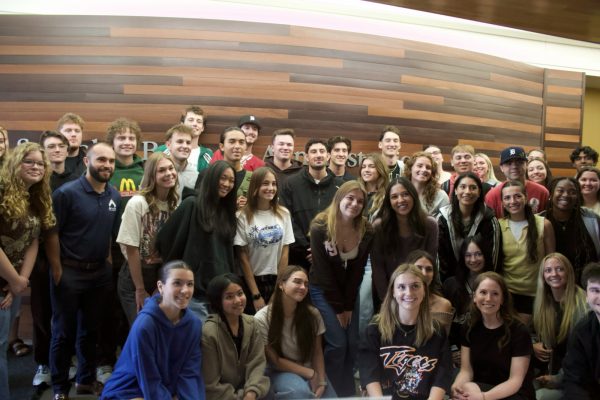The rising trend of collegiate esports
It’s Christmas morning in 1972 — boys and girls all across the country are plugging in and playing games like table tennis and football on their new Magnavox Odyssey. This marked the beginning of the world of video games.
Fast forward to 2022, where consoles like the PlayStation 5 and the Xbox Series X are more powerful than ever, while computers are getting stronger every week.
People have been playing video games competitively for as long as they have existed, but 20 years ago the act of watching competitive playing from the comfort of your own home emerged. This became even easier in 2011 when the streaming platform Twitch launched, giving esports athletes a new platform to showcase their hard work and talent.
Today there are over 300 esports teams, and that number is constantly growing. What has led to this sudden explosion of collegiate esports, and where is it heading in the future?
Oakland University (OU) Director of Athletics Steve Waterfield says the interest has always been there — colleges are just now providing an opportunity for student athletes to engage in their interests at a varsity level.
“People have played these games and as they get older they get to college,” Waterfield said, “and one of the things college does is, it provides opportunities for community in a setting.”
The trend has only grown during the COVID-19 pandemic, creating more opportunities for the gaming community to gather. This pandemic-borne surge in playing has translated into colleges picking up on the trend, as well.
College sports is a huge part of American culture, and with the addition of esports, it reaches entirely different generations. Gen-Z and Millennials are not only playing games, but watching them, as well.
It’s clear colleges are starting to add varsity esports programs to their itineraries — but why is it so important for them to do it now? For OU esports head coach Carl Leone, it comes down to three things: marketing, recruitment and retention.
“You reach a lot of students that you would never reach — students who’ve never heard of Oakland University — through college esports,” Leone says.
Leone said when students come to a university, follow through with their degree and graduate, it not only helps them, but helps the university they attend. Some students come in for a year and leave, but esports can assist in keeping them around longer.
“The varsity esports program helps give those students a sense of purpose, a team belonging, team identity and to give them something that — in addition to academics — helps to grow them as well-rounded individuals, and something to give them a lot of excitement,” Leone said.
The emergence of the National Association of Collegiate Esports (NACE) gave collegiate esports a home. NACE assists colleges and universities with bringing these varsity programs to college by providing things like scholarships and increasing eligibility.
NACE was given this opportunity when the National Collegiate Athletic Association (NCAA) voted against becoming the governing body of collegiate esports in 2019. While NACE formed in 2016, it was this declaration by the NCAA that really propelled them to being the collegiate esports juggernaut they are.
“Esports is almost the model — they’ve talked about power five football breaking away, having its own thing, but esports already got there,” Waterfield says. “NACE stepped in and it’s done a very good job filling that void and offering those opportunities.”
With NACE being solely focused on esports, it can support those involved and give esports its undivided attention while the NCAA has to worry about its wide array of collegiate sports. NACE also partners with Twitch, which gives them access to the largest streaming platform for games as a bonus.
What the future holds
Esports is a relatively new concept for colleges, but for Leone, it means more staffing jobs for varsity programs.
“Typically, there’s one head coach or director of the program as a full-time staff member, then outside of that there’s a bunch of volunteers,” he said. “You probably wouldn’t have one person coach soccer, basketball and tennis. You also wouldn’t have one person coach Overwatch, Rocket League and Smash Brothers.”
Leone said there are probably less than 10 programs which have full-time staff for each title, as with funding and budgeting for esports being relatively low, they just aren’t there yet.
As for Waterfield, he believes NCAA not picking up esports was best for collegiate esports and is interested to see how the structure continues to evolve.
“What I don’t know — and it will be fascinating — is, do you start to see some of the conference consolidation like you do now at the Division 1 level, where you start having fewer conferences with more teams?” Waterfield said.
With esports, the consolidation may look slightly different, as many teams have a variety of games they play competitively. With each different game, there is a different tournament and championship game.
When you look at other collegiate sports, each unique sport has one championship. For example, in football you have the College Football Playoff, while basketball has the NCAA Tournament.
One idea Leone said NACE and colleges should consider is having one grand event to host all of the big titles at one time. He feels this will help propel collegiate esports to the next level, along with better supporting high school esports.
“They generally have less infrastructure — lower budgets, less staff — than the college program,” Leone said. “Once we get the high school programs to be fully funded and supported by the college programs, then parents will start to see the value, and then they will be invested in it.”






